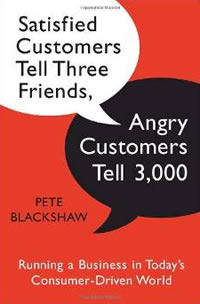
Last week George Orwell’s famous “All animals are equal but some are more equal than others” line from “Animal Farm”, his anti-totalitarianism novella, came to mind in an unusual context: customer service in a “social media world”.
Do you remember the days of the Pareto principle? Businesses used to look at the top 20%, generating 80% of the revenue, customers first? Special customer service treatment, dedicated account managers, better pricing, incentives, boat trips, you name it. Obviously, it was never exactly 20% and 80%, but you know what I mean: it’s how millions of businesses used to work and how probably millions of businesses still work.
What many businesses failed to do was identify the diamonds that were hidden in the 80%. Today they even fail more if you ask me, since I don’t see many ‘hunters’ anymore, despite lead management. Waiting for sales-ready leads sometimes seems to have become an excuse for ‘farming’. However, then again, when we generated leads in the ‘old days’,’ they often – literally – landed in the drawer of someone’s desk.
Another thing many businesses failed to do was help their customers become “bigger” customers, certainly in B2B, by supporting them through the value chain. Finally, “co-opetition” was a great book but effectively applying it by creating ecosystems with other parties in an effort to grow the business for all participants seldom happened.
The long tail and the socialization of customer service
Fast forward to the “online” age. Chris Anderson describes The Long Tail in Wired in 2004. Major shift in thinking in several companies. The revenge of the 80%, although Chris really was talking about distribution. What untapped revenue potential was there in the 80%? What was the right way to allocate budgets to generate the best ROI in taking care of the major accounts and identifying and upgrading, so to speak, the others?
In 2010 Joseph Jaffe published his Customer Service Manifesto, highlighting the shifts we saw happening. The combination of social, word-of-mouth, the public arena the online world becomes and the changes in the buying journey (information gathering, peer influence, shift from selling to buying) makes excellent customer experiences and customer service leading to new business and stronger brands. Customer service becomes essential in sales and marketing and satisfied customers become, so to speak, part of our “sales teams”. Customer service rules. Not customer service as in “solving problems” but customer service as in “providing overall excellent service, in every contact moment and touchpoint, across all channels and divisions”. It’s an evolution that’s directly linked with our modern obsession regarding influencers and the realization that the time to move away from silos is now.
Reality check: the influence dictatorship of customer service in a “social world”

Remember that Joseph wrote: “an unhappy customer will tell a million of their closest strangers”? The influence of the crowd? Power to the consumer? Or the title of Pete Blackshaw’s book: “Satisfied Customers Tell Three Friends, Angry Customers Tell 3,000: Running a Business in Today’s Consumer-Driven World”?
Time for a reality check. The inequality in customer service has never been so confusing and fragmented as it is today.
Why? First of all, customer service is still provided according to many of the old rules and is not seen as an opportunity to market. Secondly, the whole defensive and paranoid craze about reputation management and “web care”, combined with the lunacy of the way businesses deal with influence, has led to customer service prioritizations that are not solely based on the customer size but also on the influence “scores” and reputations of a new kind of “customers”: the socially influential ones.
Maybe they are good for 0.0000001% of our business but when they have high Klout or whatnot, they get a lot of attention. There are thousands of businesses, analyzing what is being said about them, and giving priority customer service based on the “influence” of who’s complaining on the social web. I have seen examples of businesses that work with color codes to define how fast they need to act. High influence? Red alarm! Mayday mayday. Answer, isolate and give preferential service.
Customer-centricity failures lead to customer service inequality
The people working in contact centers, customer service and web care teams often have no access to the resources to actually service these so-called influencers. In fact, they often have no access to the resources to properly serve any customer at all because the information and leverage they need are missing and shattered over disconnected departments and resources.
Customer service excellence is not a goal. It is a basis for business. And if businesses would focus on customer-centric processes and organizations with good customer service instead of focusing on the social reputation anxiety, they would do a much better job in serving all their customers in a smart and effective way.
Isn’t it ironic that in a so-called ‘social’ world, customer service prioritization has never been so unequal and ruled by the influence totalitarianism? I agree with what Jaffe wrote a few years back.
However, businesses are really responding in a very bizarre and paranoid way that leads to an unseen customer service chaos with an exaggerated focus on a new, socially influential elite.
That’s why I was thinking about George Orwell.

